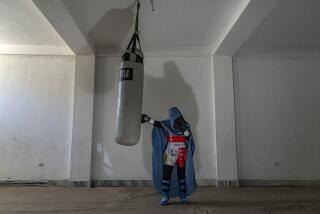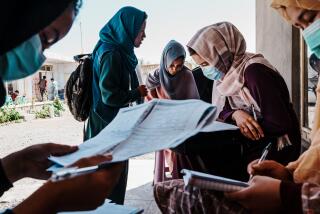A wasted Afghan winter?
KANDAHAR, AFGHANISTAN — As the U.S. Black Hawk helicopter skimmed low over the desert, the signs of approaching spring were everywhere: melting frost in the hollows, the first shoots of green in the nearby fields, shrinking snowcaps on distant peaks.
In coming weeks, winter will loosen its grip on Afghanistan. Senior NATO generals insist that their troops are well positioned to confront the Taliban offensive that is expected to follow.
But some analysts, diplomats and other observers think the Western alliance, and the Afghan government it supports, has failed to use winter’s relative lull in fighting to seize the initiative in advance of a new battle with the insurgents.
The North Atlantic Treaty Organization’s forces in the south are being bolstered, but the influx of about 3,000 additional troops is privately described by field commanders as both tardy and considerably smaller than what they had hoped for.
The reinforcements will come almost exclusively from the United States and Britain; troop commitments by other alliance members have failed to materialize.
In some key districts, Taliban militants have reinfiltrated areas they were driven from months ago. Even before the start of any large-scale offensive, the insurgents are demonstrating an ability to capture territory, including their brazen seizure of the town of Musa Qala in Helmand province this month.
With Western troop levels at their highest since the fall of the Taliban in 2001, including a record 26,000 U.S. soldiers, senior NATO officials in Kabul, the capital, described the insurgents as scattered and demoralized after defeats last year -- the bloodiest year of the conflict, with about 4,000 people killed.
The Taliban harbored ambitions of seizing Kandahar, the movement’s onetime stronghold, but were blocked in that drive last autumn, though fighting came within 10 miles of the city.
“2006 was a year of Taliban failure,” said British Gen. David Richards, who turned over command of NATO forces to U.S. Army Gen. Dan McNeill this month. “The Taliban did not achieve a single objective.... We proved that NATO can and will defeat the Taliban militarily.”
But commanders of remote coalition outposts that have come under frequent hit-and-run attacks this winter describe a resourceful and determined foe they think will be back in force to fight again.
“They’re hard-core -- very determined, very disciplined. They know the ground and they know how to fight, and they know how to adapt to changing conditions,” said Canadian army Capt. Piers Pappin, whose mud-walled, thatched-roof outpost in the desert west of Kandahar was repeatedly attacked by bands of insurgents, even during the supposed winter lull.
Insurgent commandants have boasted that in coming months they will step up the use of crude yet lethal tactics such as suicide and roadside bombings, with which they can counter NATO troops’ vastly superior firepower.
Suicide attacks increased fivefold in 2006, and the use of remotely detonated devices nearly doubled from the previous year, according to U.S. military figures.
‘The call of extremists’
In Afghanistan’s impoverished south, which is expected to be the focal point of fighting in the spring and summer, the slow pace of reconstruction has hurt allied military efforts to build the trust of villagers.
“While the growing insurgency is attracting increasing attention, long-term efforts to build the solid governmental institutions a stable Afghanistan requires are faltering,” the Brussels-based International Crisis Group said in a report released at the end of January. As a result, “disillusioned, disenfranchised Afghans are ... responding to the call of extremists.”
Aid groups and nongovernmental organizations have characterized the reconstruction effort as falling far short of the targets set a year ago by Western nations and the Afghan government.
“So much could have been done over the winter to make these people’s lives better,” said Norine MacDonald, who works in Kandahar province in village outreach programs sponsored by the nonprofit Senlis Council. “Instead, their situation is getting worse all the time.”
Heading into the next round of fighting, the dubious efficacy of the Afghan army is also a growing cause for concern. Coalition goals call for the force to expand to 80,000 troops by next year, but at this point, struggling with a high desertion rate, it is fielding about 20,000.
Senior Western military officials put a positive face on the progress made in arming and training the force. But field-level allied officers who work closely with the Afghan troops privately predict that it will take many years to shape them into a professional army capable of confronting the insurgents on their own.
The Afghan troops protest that they are counted on to smooth over anger when NATO operations result in civilian deaths and injuries. At least 100 Afghan civilians died last year at the hands of allied forces, according to New York-based Human Rights Watch, and Afghan rights groups put the figure many times higher.
“Whenever they do something that is against our culture, people get angry, very angry,” said Lt. Col. Sheehin Shah Kabandi, a regional Afghan army commander in Kandahar. “We remind them again and again: If you enter someone’s house by breaking down his door, that man and all his relatives are your enemy forever.”
Local resentment is sometimes inflamed by what Western military officials see as an effort by Afghans to better their lot. In the Panjwayi district outside Kandahar, NATO troops for months have been bulldozing vineyards, arbors and orchards to build three wide roads radiating from their bases. Alliance officials say the roads will be an economic boon to villagers.
But some farmers said that promised compensation never arrived and that the roads appeared to be mainly for the troops’ use.
“What do we gain?” said a weathered villager named Rahmatullah, bent nearly double under a load of dry sticks. “My grapes are gone, and I have nothing.
“I’m angry at the Taliban who were hiding here, but I’m angry at them too,” he said, pointing with his chin toward NATO combat engineers leveling ground for the latest stretch of road.
Civilian casualties
As they seek to benefit from any NATO missteps, the insurgents have honed their tactics. Western commanders describe how the insurgents seed an area with arms caches, then blend with farmers and villagers until they are ready to pick up their weapons and fight.
One commander at an outpost near Kandahar said he was grudgingly impressed when Afghan men who later proved to be insurgents loitered in a field by day, stacking stones that hours later were used to precisely position a rocket-propelled grenade launcher for a nighttime attack.
During a sweep last month, NATO soldiers found a compound that apparently had been used as an insurgent field hospital, with bandages, syringes and painkillers, within 200 yards of a troop outpost.
When the insurgents are able to establish themselves in a populated area, coalition forces face a difficult decision: whether to risk civilian casualties by attacking.
Musa Qala, a town in Helmand province’s poppy-growing belt that was overrun by the Taliban early this month after a British-brokered truce collapsed, is a case in point.
NATO used a pinpoint airstrike to kill the Taliban commander who had led the takeover and said it would evict the rest of the insurgents when it was ready to do so. But military officials acknowledged it would be difficult to dislodge the Taliban fighters without inflicting civilian casualties, even though many residents had fled.
Civilian deaths have become a highly sensitive subject, particularly after Afghan President Hamid Karzai publicly broke into tears late last year while imploring allied troops to be more careful.
Bombers-in-waiting
Air power has become a much-relied-on advantage for coalition troops, but in addition to the risk of civilian casualties, springtime fighting will bring other challenges: for example, keeping helicopters and other aircraft in the skies when dust storms send columns of fine, sandy grit thousands of feet aloft.
Low-altitude surveillance carries the risk of drawing fire, but from higher altitudes “it’s really hard to tell what’s a threat and what isn’t,” said Sgt. Scott Campbell, a Black Hawk gunner with the Army’s 10th Mountain Division at the Kandahar base.
Travel on the ground is also dangerous. Over the last several months, Taliban commanders have boasted that hundreds of would-be suicide bombers are waiting to be sent into action. Afghan and coalition arrest figures seem to bear out the claim; during one recent week, nearly a dozen suspected bombers-in-waiting were detained in and around Kandahar.
As a result, coalition convoys tend to race through the city after dark rather than moving about freely during the day.
Late one moonless night last month, NATO soldiers prepared for a run that would take their armored vehicles through downtown Kandahar and deep into the desert. With the engines rumbling, they listened to a squad commander’s grim and detailed litany of attacks that had taken place recently in the area.
“What I’d say is this: Try not to stop,” he told them. “Really try not to stop.”
Everyone nodded.
More to Read
Sign up for Essential California
The most important California stories and recommendations in your inbox every morning.
You may occasionally receive promotional content from the Los Angeles Times.










